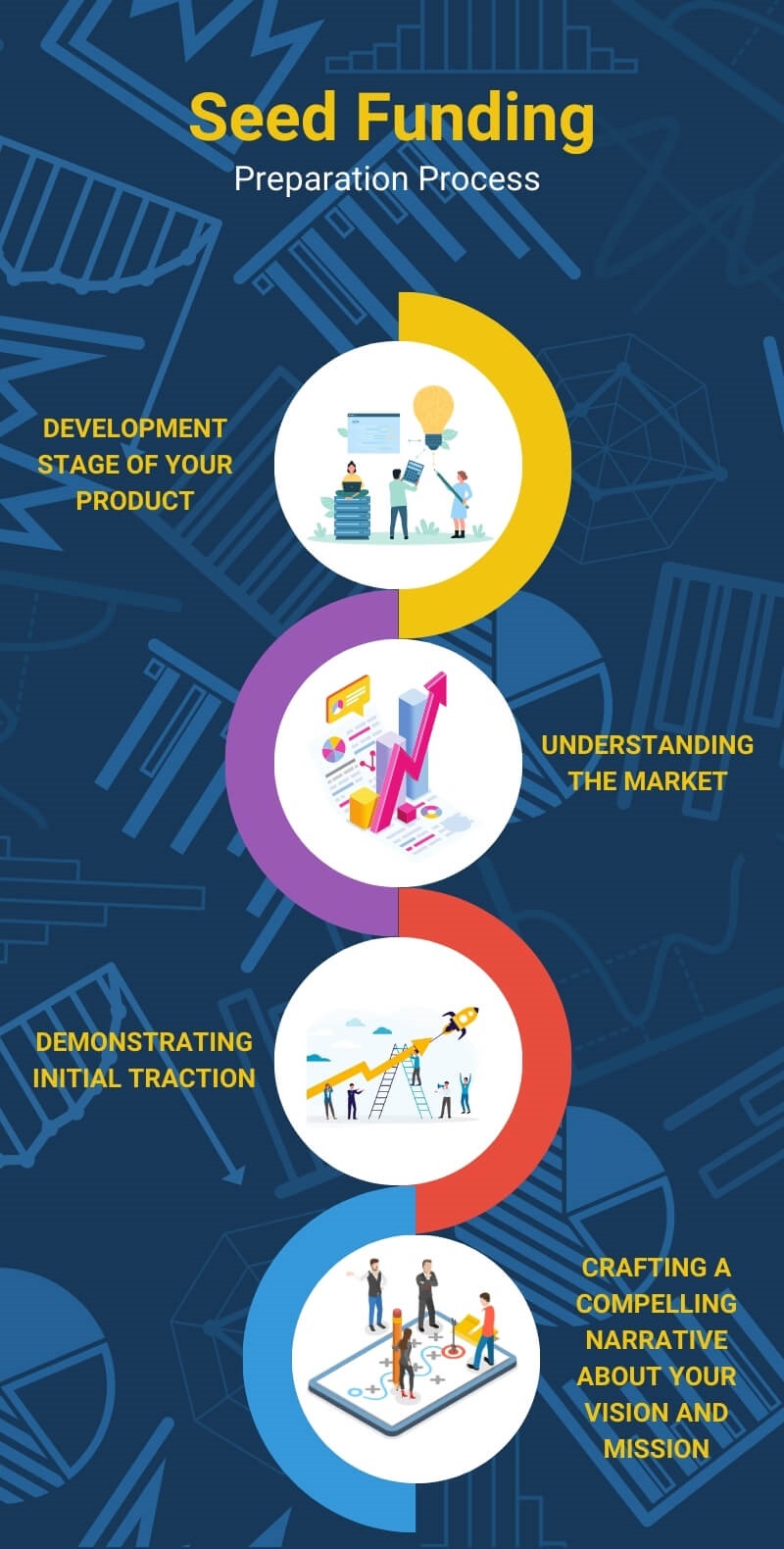Seed funding represents the critical early investment that can turn a startup from concept to reality. It is the initial infusion of capital that supports a business until it can generate cash of its own, or until it is ready for further investments.
It is essential for startups as it allows them to develop their product, hire staff, and perform market research without the immediate pressure of generating revenue. Unlike personal savings or contributions from friends and family, seed funding offers a substantial financial runway, allowing startups to aim higher and think bigger.
Let’s talk about it.
Table of Contents
TogglePreparing for Seed Funding
With investments ranging between $500,000 to $2 million, securing seed funding is a pivotal step for startups looking to make their mark in their respective industries. You can see there is a lot to gain from this approach, right? So you should prepare yourself carefully.
Baby Steps
Preparing for seed funding requires an evaluation of your startup’s readiness. The preparation process involves several key areas, including:

Startups must showcase a clear problem-solving approach that adds substantial customer value, supported by evidence of product-market fit. This involves recognizing customer needs deeply and presenting a solution that addresses these needs effectively.
Investors are keen on investing in teams that have a solid understanding of their market’s size and dynamics, as well as a credible plan for capturing a significant share of this market.
This stage of preparation is about painting a picture of a startup that not only has a groundbreaking idea but also the capability and strategy to make it a market success.
Financial Planning and Amount to Raise

Financial planning for a seed funding round is a balancing act between growth ambitions, equity dilution concerns, and runway needs. Calculating how much to raise involves:
- Forecasting development
- Marketing
- Operational costs against anticipated revenue growth
Founders should aim for an amount that enables them to reach key milestones, ideally leading to profitability or a position of strength for subsequent funding rounds.
It’s recommended to give up 10% of equity to preserve control and flexibility for future rounds. The budget allocation should reflect the startup’s strategic priorities, ensuring that funds are invested in areas that drive growth and market penetration.
Careful planning and justification of the amount to raise are critical in discussions with potential investors, demonstrating a thoughtful approach to scaling the business and managing resources efficiently.
Choosing the Right Financing Option
Seed funding can come from various sources, each with its own set of advantages and considerations.
Here are some of the most popular ones:
| Financing Option | Description | Suited For |
|---|---|---|
| Equity Financing | Capital exchanged for company shares. | Seeking investment and strategic partners. |
| Convertible Debt | Loan converting to equity in future rounds, with interest. | Postponing valuation and expecting growth. |
| SAFEs | Investment converts to equity later, no interest or maturity date. | Favoring simplicity and flexibility. |

Equity financing involves trading company shares for capital, providing investors with immediate ownership but requiring a valuation of the company. Convertible debt is a loan that converts into equity during a future financing round, often including interest and a maturity date, making it more complex but flexible for early-stage startups.
SAFES have gained popularity for their simplicity and founder-friendly terms, lacking interest rates or maturity dates, and converting into equity based on future valuation.
Choosing the right financing option depends on the startup’s valuation, negotiation leverage, and strategic goals, requiring founders to carefully assess each option’s implications for future control and financial health.
Finding and Approaching Investors

Identifying and engaging potential investors is a critical step in the seed funding process. Startups can look towards angel investors, venture capitalists, and crowdfunding platforms as sources of seed capital.
Interesting Fact: “Only 20% of companies that raise a seed round ever go on to raise a Series A.” – Silicon Valley Bank
Each investor type brings different advantages, from the mentorship and networks of angel investors to the larger capital and resources of venture capitalists. Crowdfunding can validate the product concept and engage a broader community, though it often requires a compelling story and strong marketing efforts.
Of course, building a company without external capital is indeed possible.
Here are the commonest types of crowdfunding you should be on the lookout for:
| Type of Crowdfunding | Description | Pros | Cons |
|---|---|---|---|
| Reward-based | Funds exchanged for rewards, usually a product or service. | – No equity lost – Market validation |
– Risk of not meeting funding goals – Reward fulfillment challenges |
| Equity-based | Investors get company shares. Suitable for high-growth startups. | – Access to larger capital – Investor networks |
– Dilutes ownership – Regulatory hurdles |
| Debt-based (P2P lending) | Functions like a traditional loan but from the crowd. | – No loss of equity – Fixed repayments |
– Repayment obligation – Possible interest costs |
| Donation-based | Funds donated for social good, without financial return expectations. | – Supports social causes – Builds community |
– Limited to social projects – Uncertain funding |
Networking, industry events, and introductions from mutual connections are valuable for making initial contacts. A targeted, personalized approach to investor outreach increases the chances of securing meetings and eventually, investments.
Crafting a Pitch
A compelling pitch is crucial for converting investor interest into funding. The pitch deck should clearly articulate:
- The startup’s value proposition
- Market opportunity
- Business model
- Traction to date
Essential elements include the problem statement, solution, target market, competitive analysis, financials, and the team. Tips for a successful pitch include telling a compelling story that connects emotionally, demonstrating deep market understanding, and presenting a clear growth plan.
Common mistakes to avoid are overcomplicating the presentation, failing to address potential risks, and neglecting the ask – specifically, how much is being raised and the terms. Preparing for questions on valuation, market entry strategy, and long-term vision is also essential.
The goal is to leave investors with a clear understanding of why your startup is a valuable investment opportunity.
Negotiating and Closing the Deal

Understanding term sheets, negotiations, and legal considerations is the final hurdle in securing seed funding. Term sheets outline the key terms and conditions of the investment, serving as the basis for legal documents.
Founders should focus on terms that affect control, such as board composition and voting rights, and economic terms like valuation and liquidation preferences. Negotiations require a balance between maintaining a good relationship with future partners and protecting the startup’s interests.
Legal documentation, including the cap table and investment agreements, formalizes the investment. Founders should seek legal advice to ensure that all agreements align with the startup’s long-term goals.
The Bottom Line
The road to securing your first investment is quite a long one, but it is not impossible by any means.
I am sure you will find my two cents on this process to be of much help in your future strivings.
Related Posts:
- Waza Emerges from Stealth with $8 Million Seed…
- How To Do SEO for Your Startup Website - Search…
- How to Validate Your Startup Idea - Idea Screening Explained
- First Time Logging into Gimkit - A Guide for Beginners
- Is True Anonymity Online Possible? What You Can Do…
- How to Get a Startup Business Loan with No Money -…










